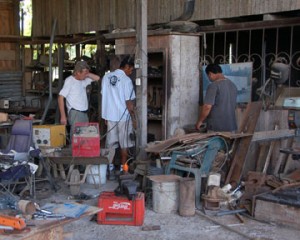 The water is almost perfectly smooth, the wind calm. I am silent, breathing slowly through my nose, which hovers just above the languid surface. My legs and arms are hidden, swirling in smooth circles as they tread the aqueous space below. From this vantage I am a sea turtle lifting my head from the echoing blue to peer momentarily at the world of imposing gravity. I imagine myself all shell and flipper, completely at ease in the ocean realm.
The water is almost perfectly smooth, the wind calm. I am silent, breathing slowly through my nose, which hovers just above the languid surface. My legs and arms are hidden, swirling in smooth circles as they tread the aqueous space below. From this vantage I am a sea turtle lifting my head from the echoing blue to peer momentarily at the world of imposing gravity. I imagine myself all shell and flipper, completely at ease in the ocean realm.
Nearby a tern is fishing, nonplussed by my presence; after all, I am nothing but a brown spot bobbing in the expanse. The bird comes very close. It sways above me—delicate, slim and white with a split tail—searching. Each time it dives and strikes for food its flow is halted, a quick snap against the water. I love this place. Here, the Osa Peninsula and Gulfo Dulce wrap together like a vibrant Taiji (yin-yang) symbol of land and water. And I’m thankful to feel the embayment’s sweet coolness against my skin since, even this early in the morning, the January air is hot and sticky.
 In 2007 and 2008, I worked as a research assistant for Friends of the Osa (http://www.osaconservation.org/), tagging sea turtles and collecting nesting data on the Pacific side of the Osa Peninsula . Now I’ve returned for a unique pilot study under their auspices. A projected yellowfin tuna farm at the mouth of Golfo Dulce has sparked an urgent call to action. Since little has been published about the gulf’s ecological vitality, there is an imperative need for more scientific data to bolster conservation initiatives. So I am here to talk with the people and collect 30 days data from a small boat, documenting marine animals in Golfo Dulce, especially “flagship” conservation species (whales, dolphins, sea turtles, whale sharks and some beautiful yellow xanthic-phase sea snakes). My goal is to garner baseline data about this tropical fiord’s unique biodiversity and build greater awareness concerning the importance of in situ conservation.
In 2007 and 2008, I worked as a research assistant for Friends of the Osa (http://www.osaconservation.org/), tagging sea turtles and collecting nesting data on the Pacific side of the Osa Peninsula . Now I’ve returned for a unique pilot study under their auspices. A projected yellowfin tuna farm at the mouth of Golfo Dulce has sparked an urgent call to action. Since little has been published about the gulf’s ecological vitality, there is an imperative need for more scientific data to bolster conservation initiatives. So I am here to talk with the people and collect 30 days data from a small boat, documenting marine animals in Golfo Dulce, especially “flagship” conservation species (whales, dolphins, sea turtles, whale sharks and some beautiful yellow xanthic-phase sea snakes). My goal is to garner baseline data about this tropical fiord’s unique biodiversity and build greater awareness concerning the importance of in situ conservation.
A man is suddenly talking on the pier, his voice pours across the bay to where I am swimming. I roll onto my back and sigh contentedly. Floating, ears muffled by water, I fall deaf to his chatter, soaking in my own thoughts. I ponder the work I’ve been doing this week, interviewing local fishermen. Skin weathered to rich mahogany working the sea aside brothers and friends, these earnest men are skeptical of questioning strangers. Their eyes are often shadows as I approach. Yet I’ve felt the honor of having them warm to me and I’m humbled by their hard-earned knowledge of the gulf and its fauna. They have been generous with information and kind of heart, and my Spanish improves with every effort to understand their dynamic stories. Yesterday, two people told me they saw Humpback whales just the day before, four individuals from the northern hemisphere breaching in the gulf. These reports make me itch to get on the water myself and, after a few more interviews, I’ll be ready.
But, like most projects, mine is facing some obstacles—an unexpected and fairly expensive repair is needed on the motor donated for my study. So my boat sits waiting. I wait too while we search for a solution, an easier fix or alternative. A half hour has passed since I paddled out into the water and the sun is throwing light across a spray of clouds that are thin and broken into a pattern of triangles, like white scales on a blue fish. Please, I whisper a tiny prayer skyward, I need a boat with a working motor… and soon.
 Twisting upright, I see the white tern is gone. The tide is rising and dark wrinkled water is coming a few hundred yards away. When the tiny ripples reach me along with the breeze that’s pushing them, I close my eyes and sniff the fresh salty air. Another beautiful morning in Costa Rica . It’s time to start the day. With one more deep breath, I turn toward shore and begin to pull myself, one arm over the other.
Twisting upright, I see the white tern is gone. The tide is rising and dark wrinkled water is coming a few hundred yards away. When the tiny ripples reach me along with the breeze that’s pushing them, I close my eyes and sniff the fresh salty air. Another beautiful morning in Costa Rica . It’s time to start the day. With one more deep breath, I turn toward shore and begin to pull myself, one arm over the other.



